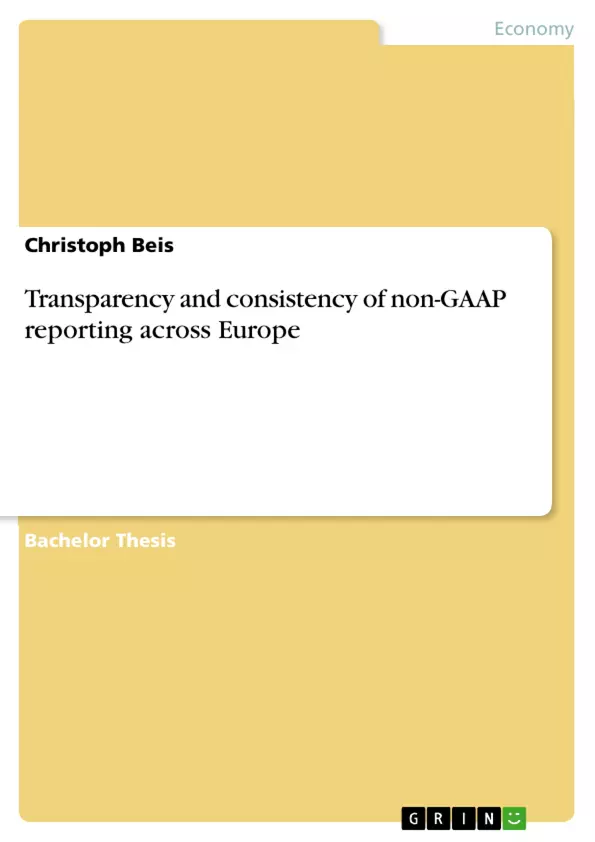Non-Generally Accepted Accounting Principles (non-GAAP) measures are figures that are not legally defined as opposed to GAAP measures which are specified by the laws of every country in order to ensure a true and fair view. The European non-GAAP disclosures will be examined with respect to transparency and consistency across companies, countries and time horizons.
The thesis will point out the ambiguous character of non-GAAP reporting, being both informative and opportunistic. The carried out sample studies of European firms previous findings that non-GAAP reporting is a common procedure in Europe and that usage varies across European countries and industries. Moreover, it extends existing literature by showing that measures even vary within the same industry and over time and that individual factors, such as the variable pay determination of executives, might be explanatory factors for the usage of non-GAAP figures.
Inhaltsverzeichnis (Table of Contents)
- Introduction
- The use of non-GAAP disclosures in financial reporting
- Characteristics of non-GAAP measures
- Ambiguous character of non-GAAP reporting
- Informative character
- Opportunistic character
- The European regulatory environment
- National regulatory environment across countries
- European supranational regulatory environment
- International Financial Reporting Standards
- Empirical evidence about non-GAAP reporting
- Usage of non-GAAP reporting across Europe
- Disclosure of non-GAAP measures
- Adjustments of GAAP measures
- Prominence of non-GAAP measures
- Reconciliations to GAAP measures
- Factors influencing non-GAAP reporting
- Macroeconomic factors
- Institutional environment
- Economic environment
- The introduction of IFRS
- Company-specific characteristics
- Independence of Board of Directors
- Executive compensation
- Information environment
- Miscellaneous
- Macroeconomic factors
- Usage of non-GAAP reporting across Europe
- Sample study
- Usage of non-GAAP reporting in the investigated companies
- Disclosure of non-GAAP measures
- Adjustments of GAAP measures
- Prominence of non-GAAP measures
- Reconciliation to GAAP measures
- Company-specific characteristics
- Cross-country comparison
- Usage of non-GAAP reporting in the investigated companies
Zielsetzung und Themenschwerpunkte (Objectives and Key Themes)
This paper examines the transparency and consistency of non-GAAP reporting across Europe, focusing on how companies use non-GAAP measures in their financial reporting. The study aims to understand the factors influencing the use of non-GAAP measures and to analyze their impact on the transparency and consistency of financial information provided to investors.
- Characteristics and ambiguity of non-GAAP reporting
- European regulatory landscape for non-GAAP reporting
- Empirical evidence on non-GAAP reporting practices in Europe
- Factors influencing the use of non-GAAP measures
- Impact of non-GAAP reporting on transparency and consistency
Zusammenfassung der Kapitel (Chapter Summaries)
The first chapter introduces the topic of non-GAAP reporting, defining its key features and highlighting its increasing popularity both in the U.S. and Europe. It also presents the structure of the paper, outlining the main chapters and their respective focuses.
Chapter 2 provides a detailed analysis of non-GAAP reporting practices, discussing its characteristics, advantages, and disadvantages. It further explores the ambiguous nature of non-GAAP reporting, examining both its informative and opportunistic aspects.
Chapter 3 focuses on the European regulatory environment for non-GAAP reporting. It describes the national regulatory landscape across different countries, emphasizing the differences in regulations. It then moves on to discuss the supranational regulatory environment, highlighting the role of the European Securities and Markets Authority (ESMA).
Chapter 4 presents empirical evidence on non-GAAP reporting practices across Europe. It analyzes the usage of non-GAAP measures, including their disclosure, adjustments, prominence, and reconciliation to GAAP measures. It also explores the factors influencing non-GAAP reporting, focusing on macroeconomic and company-specific characteristics.
Chapter 5 examines European annual reports with a focus on the transparency and consistency of non-GAAP reporting practices. It compares the findings to previous research and analyzes the cross-country variations in non-GAAP disclosures.
Schlüsselwörter (Keywords)
Non-GAAP reporting, transparency, consistency, European financial reporting, regulation, empirical evidence, factors influencing non-GAAP reporting, cross-country comparison.
- Quote paper
- Christoph Beis (Author), 2017, Transparency and consistency of non-GAAP reporting across Europe, Munich, GRIN Verlag, https://www.grin.com/document/1268613



